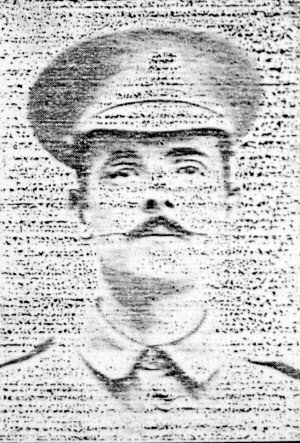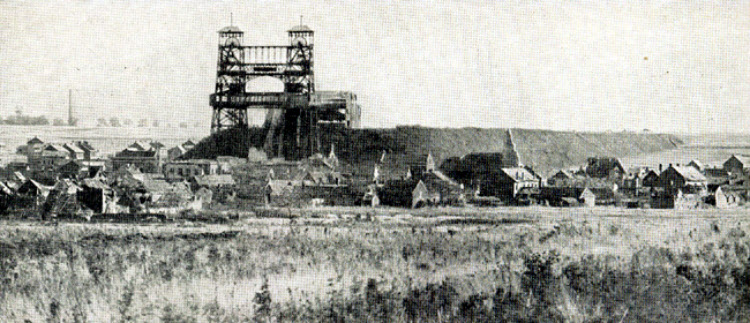
There were two Ossett born men named Ernest Dews who died in action in WW1. The second, Private Ernest Dews was born in Ossett on the 5th March 1879, the son of woollen weaver George Dews and his wife Emma (nee Lucas) who married in 1863. After the death of George Dews in 1881, his widow remarried ironworker Henry Bentley in 1890 and the family, including Ernest Dews, lived in Victoria Street, South Ossett. By 1901, Ernest was living with his brother Erastus Dews and his wife Alice on Horbury Road, Ossett.
Ernest Dews was a joiner and carpenter by trade and married Elizabeth Alexander (born Mirfield in 1886) in early 1904 at Ossett. Their first child, Edith Annie Dews was born in Ossett in late 1904. By 1911, Ernest Dews had moved to live in Putney, London and another child, Ernest J. Dews was born there in December 1913.
He enlisted at Wandsworth, London with the Buffs (East Kent Regiment), 8th Battalion on the 31st August 1915, less than one month before his death at the Battle of Loos at the age of 35 on the 26th September 1915. Private Dews was awarded the Victory, British and 1915 Star Medals posthumously.
The Battle of Loos was the largest conflict for the British Expeditionary Force in the war to that time: six divisions, that is 75,000 men, would take part. It was the debut of the divisions of the “New Army” and the decision had been taken to use chlorine gas and smoke as there was a shortage of shells for the artillery. The battle opened on the 25th of September. In many places British artillery had failed to cut the German wire in advance of the attack. Advancing over open fields within range of German machine guns and artillery, British losses were devastating. However, the British were able to break through the weaker German defences and capture the town of Loos, mainly due to numerical superiority. When the battle resumed the following day, the Germans were prepared and repulsed attempts to continue the advance. The reserves were committed against strengthened German positions and the twelve attacking battalions suffered 8,000 casualties out of 10,000 men in four hours. Some of the divisions did actually reach the enemy’s trenches, but their bodies could be seen draped on the barbed wire. The Buffs (East Kent Regiment), 8th Battalion were part of the 72nd Brigade of 24th Division (New Army) at the Battle of Loos. They were placed in a very difficult area on the 26th September 1915 when Private Dews lost his life. The following extract from a longer report 1 describes what happened on that day:
“The four battalions of 72nd Brigade advanced over open ground, starting some 1000 yards West of the La Bassee road, and were in such good order that they had the effect of reinvigorating 63rd Brigade on their right. However, once again men of this Brigade lost direction and moved towards the summit of Hill 70, taking them across direct fire from Chalet Wood and Bois Hugo, both places they should have been approaching frontally. The advance of 72nd Brigade, composed now of 8/Royal West Kents and 9/East Surreys, together with half of 2/Welch, came under severe enfilade and frontal fire which included point-blank artillery. These units also reported British shellfire falling among them. 8/Buffs, 8/Queen’s, 11/Essex and 9/Suffolks were all pushed into this murderous area. (The first three named all lost their Commanding Officers, killed in action here). Only a thin line reached the virtually undamaged German wire by about 1.00pm. All attempts to cut the wire failed with heavy casualties, and the remaining men took cover in long grass. At a shouted order to retire, men withdrew – many being hit by machine-gun fire as they did so. Those who did not retire were killed or captured.”
The “Ossett Observer” 2 carried this report of the death of Private Dews as a postscript to the death of his nephew, Willie Dews:
“Private Ernest Dews (36), East Kent Regiment (“The Buffs”), who until recently lived at South Ossett, has lost his life. Formerly employed as a golf stick maker at a Horbury athletic goods factory, he went to work in London, and enlisted at the outbreak of the war. Following twelve months’ training, he proceeded to the Western Front and within a month of his arrival in France, he was reported missing after the Battle of Loos, the War Office intimating later that he must be regarded as dead. He leaves a widow and two children. One of his few soldier comrades who survived the battle referred to states that he saw Private Dews blown to pieces during the enemy bombardment of the trenches.”

Above: The mining town of Loos (pronounced “Loss”), dominated then by the ironwork of a pit winding gear known to the British as “Tower Bridge” as it was in 1915. Behind it, the heights of the long Loos Crassier (slag heap) and the railway running up to the pit head. Loos today bears scant resemblance to this.
Private Ernest Dews, aged 36 years, died on the 26th September 1915 and is remembered on Panel 15 to 19 at the Loos Memorial,3 Pas de Calais, France. The Loos Memorial forms the sides and back of Dud Corner Cemetery. Loos-en-Gohelle is a village 5 kilometres north-west of Lens, and Dud Corner Cemetery is located about 1 kilometre west of the village, to the north-east of the N943, the main Lens to Bethune road.
Dud Corner Cemetery stands almost on the site of a German strong point, the Lens Road Redoubt, captured by the 15th (Scottish) Division on the first day of the battle. The name “Dud Corner” is believed to be due to the large number of unexploded enemy shells found in the neighbourhood after the Armistice.
The Loos Memorial commemorates over 20,000 officers and men who have no known grave, who fell in the area from the River Lys to the old southern boundary of the First Army, east and west of Grenay. On either side of the cemetery is a wall 15 feet high, to which are fixed tablets on which are carved the names of those commemorated. At the back are four small circular courts, open to the sky, in which the lines of tablets are continued, and between these courts are three semicircular walls or apses, two of which carry tablets, while on the centre apse is erected the Cross of Sacrifice.
References:
2. “Ossett Observer”, 7th October 1916